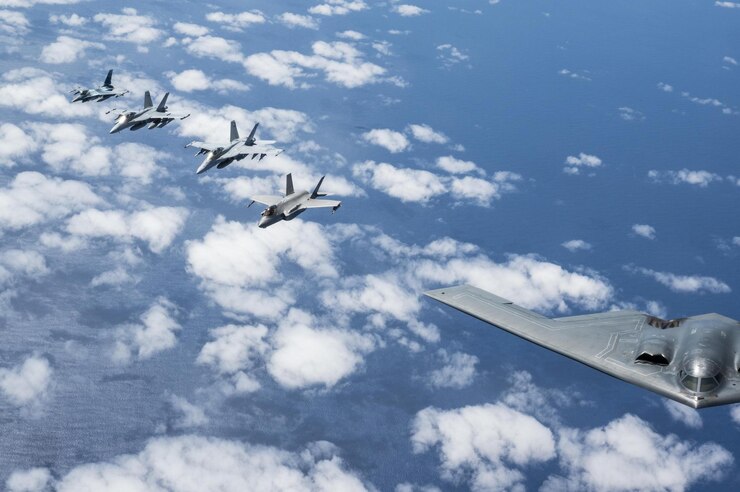Tensions between the United States and China have escalated recently, highlighted by a series of incidents involving military aircraft. Most notably, Chinese jets scrambled to intercept a U.S. military plane over the South China Sea, underscoring the increasingly fraught relationship between the two nations. This incident not only raises questions about military protocols and safety but also reflects broader geopolitical tensions that could have significant implications for global stability.
Background of U.S.-China Military Encounters
The South China Sea has long been a flashpoint for U.S.-China relations, with both nations asserting their interests in the strategically vital region. The U.S. conducts regular reconnaissance flights to monitor Chinese military activities and ensure freedom of navigation in international waters. However, these operations often provoke strong reactions from Beijing, which views them as violations of its sovereignty.Historically, encounters between U.S. and Chinese military aircraft have been tense. A notable incident occurred in April 2001 when a U.S. Navy EP-3 reconnaissance plane collided with a Chinese fighter jet, resulting in the death of the Chinese pilot and a diplomatic crisis that lasted for weeks. This incident set a precedent for how both nations handle military encounters, highlighting the potential for miscommunication and escalation.
The Recent Incident
In late November 2024, a U.S. military surveillance plane was conducting routine operations over the South China Sea when it was intercepted by several Chinese fighter jets. According to reports, the Chinese jets approached aggressively, prompting the U.S. aircraft to alter its flight path to avoid a potential collision. The situation escalated quickly, with both sides engaging in a high-stakes game of aerial cat-and-mouse.This incident is part of a broader trend of increased military activity in the region. The Chinese government has ramped up its military presence in the South China Sea, asserting control over disputed territories and challenging U.S. naval operations. In response, the U.S. has intensified its military engagements with allies in the region, including joint exercises with countries like Japan and Australia.
Implications for U.S.-China Relations
The interception of the U.S. military plane by Chinese jets is emblematic of the deteriorating relations between Washington and Beijing. As both nations continue to assert their influence in the Asia-Pacific region, misunderstandings and miscalculations could lead to serious confrontations.Analysts warn that incidents like these could spiral into larger conflicts if not managed carefully. The potential for miscommunication is high when military aircraft operate in close proximity to one another, especially in contested airspace. Both nations must exercise restraint and establish clear communication channels to prevent escalation.Moreover, this incident highlights the challenges facing U.S. foreign policy in Asia. The Biden administration has sought to counter China’s growing influence through a strategy of deterrence and engagement with allies. However, as tensions rise, it may become increasingly difficult to maintain this balance without provoking further confrontations.
The Role of International Law
International law plays a crucial role in navigating these complex interactions between military forces. The United Nations Convention on the Law of the Sea (UNCLOS) outlines rules governing maritime conduct and navigation rights in international waters. The U.S. maintains that its operations are consistent with international law, while China claims historical rights over vast areas of the South China Sea.As both nations continue to assert their positions, adherence to international legal frameworks will be essential in managing disputes peacefully. Diplomatic efforts must focus on establishing norms for military encounters that prioritize safety and communication over confrontation.
Navigating Tensions Ahead
The recent incident involving Chinese jets scrambling against a U.S. military plane serves as a stark reminder of the fragile state of U.S.-China relations. As both nations navigate their competing interests in the Asia-Pacific region, it is imperative that they prioritize dialogue and cooperation over aggression.
Moving forward, both countries must recognize the importance of establishing protocols for military encounters that reduce the risk of miscalculations and unintended escalations. By fostering open lines of communication and adhering to international law, there is potential for both nations to manage their differences constructively.
As global powers grapple with complex geopolitical challenges, maintaining stability in regions like the South China Sea will require careful diplomacy and mutual respect for each other’s sovereignty and interests. The world is watching closely as these two superpowers navigate their relationship amidst rising tensions and competing aspirations on the global stage.





3 Comments
Pingback: Secretive Spy Satellite Mission Set for SpaceX Launch Tonight
Okay Read More Blogs For Technology Related
Read a Blog For More Info